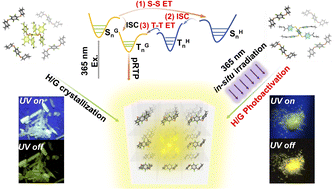Making multi-twisted luminophores produce persistent room-temperature phosphorescence†
Abstract
Multi-twisted molecules, especially those with more than four branched rotation axes, have served as superior prototypes in diverse fields like molecular machines, optical materials, sensors, and so forth. However, due to excessive non-radiative relaxation of these molecules, it remains challenging to address their persistent room-temperature phosphorescence (pRTP), which limits their further development. Herein, we develop a host–guest energy-transfer relay strategy to improve the phosphorescence lifetime of multi-twisted luminophores by over thousand-fold to realize pRTP, which can be witnessed by the naked eye after removing the excitation light source. Moreover, we employ photoexcitation-induced molecular rearrangement to further prolong the phosphorescence lifetime, which, to the best of our knowledge, is the first example of photoactivation in ordered host–guest systems. Our systems show superior humidity and oxygen resistance, enabling long-term (at least over 9–12 months) stability of the pRTP properties. By achieving pRTP of multi-twisted luminophores, this work can advance the understanding of molecular photophysical mechanisms and guide the study of more molecular systems that are difficult to achieve pRTP.



 Please wait while we load your content...
Please wait while we load your content...